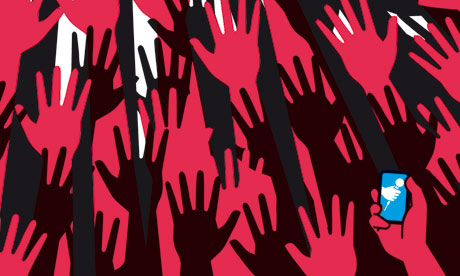Michael vom Sondern hat den post-digitalen Zeitgeist verstanden. Die Barrieren zwischen digitaler und nicht-digitaler Welt müssen seiner Meinung nach endlich abgeschafft werden. Mit dieser Forderung überschreibt vom Sondern seinen Talk-Vorschlag für die kommende NEXT Berlin 2012, mit dem er als Sprecher in den Technology-Track der Konferenz möchte.
Vor allem für Unternehmen sei es wichtig, die Sicht auf ihre Kunden anzupassen. Für vom Sondern kann es keine Einteilung zwischen digitalem und nicht-digitalem Kunden mehr geben. Vielmehr sollte ein Bild einer realen Person vorherrschen, die sich sowohl digitaler als auch nicht-digitaler Kanäle bedient, um ihren Kaufwunsch zu befriedigen.
Wie sich Unternehmen auf diese neue Sichtweise einstellen, will er auf der NEXT12 vorstellen. Hierfür hat er einen Themenvorschlag eingereicht, über den noch bis zum 20.12. abgestimmt werden kann.
Haben auch Sie ein spannendes Thema, das Sie der internationalen Digitalbranche präsentieren wollen, oder möchten Sie einen Experten auf dem Gebiet für die NEXT Berlin 2012 vorschlagen? Dazu ist unter nextberlin.eu noch bis zum 13.12. Gelegenheit.
See you at the NEXT12!
Post-Digital
Es gibt 13 Beiträge in Post-Digital.
Willkommen in der post-digitalen Welt!
Hier auf dem Fischmarkt haben wir uns von jeher der digitalen Revolution und ihrem Protagonisten verschrieben, dem interaktiven Konsumenten. Wenn wir nun „Post-Digital“ zum Motto der NEXT Berlin 2012 ausrufen, heißt das dann, dass die digitale Revolution vorbei ist? In gewisser Weise ja. Nicholas Negroponte konstatierte das Ende der digitalen Revolution schließlich bereits im Jahre 1998.
Wenn erst einmal alles digital ist, dann ist „digital“ kein sinnvolles Kriterium mehr. Wie Luft und Trinkwasser wird das Digitale nur durch seine Abwesenheit wahrgenommen, nicht durch seine Gegenwart. So fällt nur auf, wenn der Zugang zum Internet versperrt oder nicht vorhanden ist. Das Vorhandensein ist der nicht registrierte Normalfall.

Wenn alles digital ist, was kommt danach? Was ist dieses „Post-Digital“? Simon Jenkins hat darauf nun im Guardian eine ausführliche Antwort gegeben:
Post-digital is not anti-digital. It extends digital into the beyond. The web becomes not a destination in itself but a route map to somewhere real. In Marshall McLuhan’s terminology, it is cold where live is hot. This is why concerts did not die with the invention of records, but thrived on the difference. The screen relieves loneliness, as once did letters and phones, but it remains a window on the world, not a door. You cannot download the thunderous beat and sweaty presence of thousands at a Lady Gaga concert, any more than you can make love on Facebook, much as some try. You have to go somewhere for it to happen.
Online services have found it hard to „monetise“ their visits. Most offer nothing but free information and waste millions of man hours garnering unremunerative hits, whereas live uses the web to market and charge for a destination. As consumer spending evolves from „needs to wants“, from goods to experiences, the post-digital age focuses on personal contact. Post-digital is not pre-techno but exploits technology for a civilising purpose, human congregation and intercourse. The money is at the gate. This must be good news.
Mehr.
Illustration: Otto, The Guardian
Post-Digital: Ist die digitale Revolution vorbei oder hat sie gerade erst begonnen?
1998 überschrieb Nicholas Negroponte seine letzte Kolumne für Wired mit der programmatischen Zeile: Beyond Digital. Seine Zeitdiagnose damals lautete knapp: „Face it – the Digital Revolution is over.“
Wenn erst einmal alles digital ist, dann ist „digital“ kein sinnvolles Kriterium mehr. Wie Luft und Trinkwasser wird das Digitale nur durch seine Abwesenheit wahrgenommen, nicht durch seine Gegenwart. So fällt nur auf, wenn der Zugang zum Internet versperrt oder nicht vorhanden ist. Das Vorhandensein ist der nicht registrierte Normalfall.
Wie so oft waren es zunächst Künstler, die das Konzept aufgriffen. Den Begriff Post-Digital prägte Kim Cascone in seinem bereits 2000 im Computer Music Journal erschienenen Aufsatz „The Aesthetics of Failure: ‚Post-Digital‘ Tendencies in Contemporary Computer Music“.
Schnell mal neun Jahre vorgespult, und schon ist das Thema in der Agenturwelt angekommen. Russell Davies, heute Head of Planning bei R/GA London, stellte Anfang 2009 in seinem Blog die folgende Diagnose:
1. Screens are getting boring. It’s really hard to impress anyone with stuff on a screen any more. However clever you’ve been. However much thought you’ve put in. However good the tech is. No-one’s impressed. They’ve all seen better stuff in ads and movies anyway – when will onscreen stuff be as good as that? Whereas doing stuff in the real world still seems to delight and impress people. Really simple stuff with objects looks like magic. Really hard stuff with screens still just looks like media.
2. There are a lot of people around now who have thoroughly integrated ‚digitalness‘ into their lives. To the extent that it makes as much sense to define them as digital as it does to define them as air-breathing. ie it’s true but not useful or interesting.
3. The stuff that digital technologies have catalysed online and on screens is starting to migrate into the real world of objects. Ideas and possibilities to do with community, conversation, collaboration and creativity are turning out real things, real events, real places, real objects. I’m not saying that this means that these things are therefore inately better, or that the internet has ‚come of age‘ or any of that nonsense. I just mean that there are new, interesting things going on IRL and that they have some advantages (and penalties) that don’t apply online.
Ein gutes Jahr später, inzwischen ist es Mai 2010, stellen Teresa Iezzi und Ann-Christine Diaz die Frage: Are We Post-Digital Yet?
The most compelling brand ideas of the last decade have had a digital heart but have manifested themselves in meaningful ways in people’s fleshly lives–see Nike+ and Fiat Eco Drive. And, an increasingly digitized world means the internet is already all around you. The internet of things–the growing number of networked, everyday objects from fridges to pill bottles to cars–is a reality. But it seems that the idea that digital has transcended something experienced from beginning to end via a keyboard and on a screen has finally gripped the mainstream brand world.
Die beiden Autorinnen belassen es nicht beim allfälligen Hinweis auf die seit Jahren omnipräsenten Beispiele Nike+ und Fiat Eco Drive – sie bieten eine lange Liste relevanter Beispiele.
Im gleichen Jahr, Ende September 2010, droht Wieden + Kennedy via Blog: post-digital or die! Die post-digitale Welt verlange nach einem neuen Marketingmodell.
What has changed is the nature of ‚digital‘ marketing. We’ve reached a tipping point where the tech and the audience have reached a level of maturity where digital is everyday and normal. Now, what agencies and marketers need to understand is how people behave in relation to content, community, technology and media. This isn’t easy because it’s evolving rapidly and constantly. It used to be that digital shops were far better informed and connected to digital culture. But now that culture is mainstream.
Kurze Zeit später war Russell Davies vom bisherigen Verlauf der Debatte so wenig erfreut, dass er eine Entschuldigung nachschob:
Post-Digital was not intended as a sop for the complacent. It’s not supposed to suggest that ‚digital‘ is a solved problem or yesterday’s fad. It’s not a suggestion that digital* is just another channel. It’s not supposed to be a synonym for integrated, 360, channel-neutral or any of that stuff. Doing some telly AND a website does not make you Post Digital.
The only way to be a Post Digital business is to be a thoroughly, deeply, massively digital one. To be digital in culture not just in capabilities. To know how to iterate in public, to do experiments not research, to recognise that it’s quicker and better to code something than it is to describe it in meetings. You need to be part of the wider digital culture, to have good sharing habits, to give credit where it’s due, and at the very least to know how to do ellipses in Processing.
Post DIgital was supposed, if anything, to be a shout against complacency, to make people realise that we’re not at the end of a digital revolution, we’re at the start of one. The end game was not making a website to go with your TV commercial and it’s not now about making a newspaper out of your website. Post Digital was supposed to be the next exciting phase, not a return to the old order. It’s the bit where the Digital people start to engage in the world beyond the screen, not where the old guard reasserts itself.
If I’d paid more attention in history I’d probably be able to throw in a Russian Revolution analogy at this point – possibly something about the Mensheviks.
Werbe-Tausendsassa Amir Kassaei, inzwischen globaler Kreativchef von DDB, tutet in der aktuellen W&V ins gleiche Horn:
Einer der Gründe, weshalb digitale Kommunikation qualitativ weltweit nicht funktioniert: Digital wird immer noch als Medium und nicht als Infrastruktur angesehen. Auch Facebook und Co. sind keine weiteren Medienkanäle, sondern Netzwerke und Plattformen. Solange dieser Perspektivenwechsel nicht erfolgt ist, werden wir auch keinen Schritt weiterkommen.
In einigen Jahren leben wir in einer Welt, in der alles mit allem verbunden ist. Es gibt dann keine Differenzierung mehr zwischen online und analog. Dadurch sind die Menschen quasi allwissend, und zwar in Echtzeit. Marketing wird eine ganz andere Rolle spielen. Die Digitalisierung gibt den Menschen die Möglichkeit zu teilen, was sie für relevant halten. Aber sie wird keinen traditionellen Kanal ersetzen.
Wenn die Unterscheidung zwischen digital und analog wegfällt – ist dann die digitale Revolution vorüber? Oder fängt sie damit erst an?
